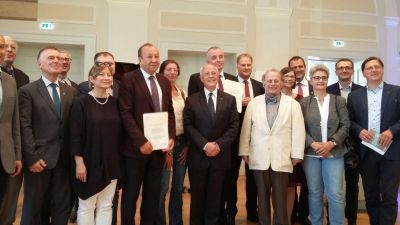Polish surnames in Germany

How did Polish names come to Germany?
The first of three waves of immigration came after the partition of Poland (1772–1795). At the time, many people in what had previously been Polish territory became Prussian citizens and later German citizens. Others left their homeland, many to go to France, but some went to other German states. The second phase of immigration took place from the second half of the 19th century during the industrialisation of Germany. During this period, up to two million people (the sources here are divided) came to the growing industrial centres on the rivers Spree, Saar, Rhein and Ruhr. The Ruhr region even had a term for it - “Ruhr Poles”. They came from the eastern Prussian provinces of Masuria and Ermland, from Silesia, from the province of Poznań and also from Congress Poland, the Russian vassal state around Warsaw. The third immigration wave came after the Second World War and after 1989, when many people left the country for economic and political reasons, some of them as (re-)settlers.
Although around two thirds of Ruhr Poles left Germany again after 1918 (either to go to the newly founded Polish state or to the Belgian and French coal regions), they have left their mark on the surname landscape – as well as on the (pop) culture – of the Ruhr area today: Inspector Schimanski, expressions such as “My dear Kokoschinski”, Emil “Ämmil“ Cervinski from the “Kumpel Anton” stories by Wilhelm Herbert Koch, or the Ernst-Kuzorra-Platz in Gelsenkirchen are testimony to this. But there are also families with Polish roots who cannot be recognised by their surname. The Wichmanns, Dombrücks and also many Meiers may have been called Wichrowski, Dąbrowski or Majchrzak.
Changing names to avoid discrimination or to identify with Germany
But just who were “the Poles” around 1900? Many of the people who came from the Eastern regions of Prussia, didn’t consider themselves to be Poles at all, instead they identified as Prussians, as Germans. After all, they were Protestant and they had their own dialect, in contrast to the Catholic Poles. The Germans, however, could not distinguish them from other varieties of Poles and so the Masurians and the Warmians were discriminated against and called “Polacks”, just like the other recent settlers from the East (the term coming from the neutral self-description “polak” for Pole). It is these immigrants in particular that were more likely to stay after the 1920s. That is why they wanted, where possible, to avoid discrimination and to assimilate. One way to do this was to Germanise their surname.
The German state supported these attempts to assimilate. In many places, a document from the Ministry of Interior from 1901 was cited; according to the Ministry “tolerance is required when Germanising Polish names. [The Interior Minister] hopes that name changes of the intended type, which are suitable for supporting the melding of the Polish element with the German, will be given every support and facilitation by the authorities.”[1] During the period between 1880 and 1935, there were 30,000 applications to Germanise Slavic names in the Ruhr area alone. As early as 1937, however, it was also estimated that “today almost every fourth East German immigrant or their descendants have a German surname in place of their original Slavic name.”[2]
Just how names were Germanised differed greatly. The chosen methods ranged from adapting the spelling of the names to translating them. The examples given below show the different methods.
How were names adapted?
Adapting the spelling
The Polish language has several sounds which the German language does not have and the Polish alphabet contains several letters and letter combinations which do not exist in German.
The simplest method, therefore, is to get rid of the diacritical signs.
Zając -> Zajac
Szymański -> Szymanski
Kałuża -> Kaluza
But this is then sometimes accompanied by a blatant change in the pronunciation of the name. For example, Zając is actually pronounced [zajɔnts], broadly in German it is: Sajonts, with a soft s as in soup. But the pronunciation [tsajak] is typical for Zajac. Kałuża is originally pronounced [kawuʒa]; the letter ł is the same sound as the English w in water, and the ż is the same sound as the J in the German pronunciation of journalist.
[1] Quoted from: Neue Namen für polnische Arbeitsmigranten. Aus Majcrzak wird Mayer, in: Kulturbetrieb Mülheim an der Ruhr (Publ.): Das Gesicht der Migration in Mühlheim an der Ruhr zeigen, 16/08/2010, URL: https://web.archive.org/web/20170812103224/https://www.muelheim-ruhr.de/cms/neue_namen_fuer_polnische_arbeitsmigranten_aus_majcrzak_wird_mayer.html (last accessed on 07/06/2023).
[2] Franke, Eberhard: Das Ruhrgebiet und Ostpreußen. Geschichte, Umfang und Bedeutung der Ostpreußeneinwanderung, Essen 1936. Quoted from: Menge, Heinz: Namensänderungen slawischer Familiennamen im Ruhrgebiet, in: Niederdeutsches Wort. Beiträge zur niederdeutschen Philologie 40 (2000), p. 119–132, here 124.
If the name is approached in terms of its pronunciation, then the spelling of the name can be adapted. However, changes in pronunciation also came about because nothing in German corresponds to the sounds that come after the letters ą, ę, ł, ń, ć, ś, ź, ż, ci, si, zi, rz, or even the y and some other combinations. But sometimes a simplified pronunciation was also desired or accepted. The Slavic origin can often still be seen.
Balcerewicz -> Balzerewitz
Frydecki -> Friedetzki
Mojzysz -> Meusisch
Baudisz -> Baudisch
Markiewicz -> Markewitz
Strzelec -> Strelec
Majchrzak -> Maischak
The consonants cz, rz, sz (for tsch, voiced and unvoiced sch) are the most affected and were mostly replaced by tz and sch. And because there were no uniform “transcription guidelines”, many different variants still exist today: Szymanski, Schymanski, Schimanski, Szimanski, Schimansky, Schimainski and more.
It cannot be ruled out that in many cases it was not the migrants themselves who chose this form of adaptation to the German spelling; instead “lazy” or ignorant officials, who wrote the name down by ear or did not have the corresponding keys on the typewriter, were often to blame.
Germanisation and partial translation
Many changes interfere with the name to an even greater extent. These changes often make the Polish origins invisible. In this case, the meaning of the name or of one of its components is adapted if it is known or transparent. Examples of this include:
Wilczewski (from wilk ‘Wolf’) -> Wolf
Słomkowski (from słoma ‘Halm‘ [stalk]) -> Hälmler
Pawlowski (from Paweł ‘Paul’) -> Paulsen
Owsianowski (from owies ‘haver’ [oats]) -> Havermann
New formation by similarity
The removal of the components of a name that are usually considered to be Polish or Slavic, mainly the typical endings, was also supposed to conceal its Polish origins. In this case, German sounding endings were sometimes used:
Henselowski -> Hensel
Mikołajczyk -> Mikola
Hetmaniak -> Hetmann
Wachowiak -> Wachner
Wiśniewski -> Wisner
This method was also taken to such extremes that only the start of the name or even just the first letter was retained:
Borsimski -> Born
Dombrowski -> Dombrück
Nowakowski -> Nolte
Lachmannski -> Lichtenstein
Majchrzak -> Mertens
New formations without any similarity
Also documented are name changes that do not have any relation to the original name:
Jadanowski -> Laarmann
Zimkowski -> Sander
How the situation looks today
Today names are Germanised far less frequently or are changed in a different way. Changing your name is actually quite time-consuming and difficult. Most people from the third immigration wave kept their name, even though the special Polish characters often disappeared. Today, they can still cause problems in many data processing systems. Then the system reverts back to standard underlying letters (e.g. ś -> s, ń -> n), phonetic adaptations such as sz -> sch hardly appear. Thanks to the freedom of movement in Europe, it is no longer necessary to adapt names. There are many Poles in Germany who do not live here permanently and therefore do not want to change their name.
The most common clearly Slavic name in Germany is Nowak. Together with the variants Nowack and Novak, it ranks 133rd in the list of most common surnames, just ahead of Grimm (as at 2005).[3] However, people with this name can also be from the Czech Republic and other Slavic countries or may be their descendants; this is particularly true of the variant with v.
In Poland, the surname Nowak is by far the most common name followed by Kowalski, which is also known in Germany (or Kowalska, the female form of the name[4]). Of the ten most common Polish surnames, six of them have the ending -ski. So it is in no way a cliché to say that that is what Polish surnames sound like. That is why the name Szymański, which has already been mentioned so often, is also in the Polish Top Ten at number 9.
Marek Firlej, June 2023
[3] Verzeichnis: Deutsch/Namen/die häufigsten Nachnamen Deutschlands, in: Wiktionary, 08/02/2023. URL: https://de.wiktionary.org/wiki/Verzeichnis:Deutsch/Namen/die_h%C3%A4ufigsten_Nachnamen_Deutschlands, (last accessed on 07/06/2023).
[4] In some Slavic languages, including Polish, Russian and traditionally Sorbian, female family member have a female form of the surname. In Poland, that relates primarily to all surnames that end in -ski, -cki, -dzki, -owy or -ewy: Wiśniewski > Wiśniewska; Konopacki > Konopacka, Rudzki > Rudzka, Stanisławowy > Stanisławowa; Paduczewy > Paduczewa. There can also be other special cases. If a Polish family emigrates to Germany, the surnames are adapted to the German system, i.e., pani Kowalska becomes Ms Kowalski, so that all family members have the same surname. In April 2023, the Federal Ministry of Justice published a draft bill on the modernisation of the law relating to the use of names. Amongst other things, this provides for Slavic families being allowed to keep their gender-specific form of the name when they immigrate to Germany. URL: https://www.bmj.de/SharedDocs/Gesetzgebungsverfahren/Dokumente/RefE_Namensrecht.pdf (last accessed on 16/06/2023).
Sources and further reading:
Books, articles and essays
Burghardt, Werner: Namensänderungen slawischer Familiennamen im Ruhrgebiet, in: Bellmann, Günter inter alia. (Publ.): Festschrift für Karl Bischoff zum 70. Geburtstag, Cologne 1975, p. 271–286.
Czopek-Kopciuch, Barbara: Nazwiska polskie w Zagłębiu Ruhry, Kraków 2004.
Loew, Peter Oliver: Wir Unsichtbaren. Geschichte der Polen im Ruhrgebiet, Munich 2014.
Koch, Wilhelm Herbert: Kumpel Anton, Essen 2020.
Marti, Roland: Schimanski & Co. an der Saar, in: Greule, Albrecht inter alia (Publ.): Studien zu Literatur, Sprache und Geschichte in Europa. Wolfgang Haubrichs zum 65. Geburtstag gewidmet, St. Ingbert 2008, p. 397–410.
Menge, Heinz H.: Namensänderungen slawischer Familiennamen im Ruhrgebiet, in: Niederdeutsches Wort. Beiträge zur niederdeutschen Philologie 40 (2000): p. 119–132, URL: https://www.mundart-kommission.lwl.org/media/filer_public/b2/c8/b2c8eaff-2c0a-49d6-bbf1-2f3d26e9ad13/band40_2000.pdf (last accessed on 07/06/2023).
Rymut, Kazimierz/ Hoffmann, Johannes: Lexikon der Familiennamen polnischer Herkunft im Ruhrgebiet (2 Bde.), Kraków inter alia 2006/2010.
Spät, Robert: Die "polnische Frage” in der öffentlichen Diskussion im Deutschen Reich, 1894-1918 Marburg 2014, URL: https://digital.herder-institut.de/publications/frontdoor/deliver/index/docId/115/file/PUB_Herder-Institut_Studien_29_9783879693863.pdf (last accessed on 07/06/2023).
Online
Firlej, Marek: Warum der Ruhrpottkomissar Schimanski heißen musste, in: :bsz online. Deine Bochumer Stadt- & Studierendenzeitung, 10/11/2014, URL: https://www.bszonline.de/2014/11/10/warum-der-ruhrpottkomissar-schimanski-heissen-musste/ (last accessed on 07/06/2023).
Kaluza, Andrzej: Migranten aus Polen im wiedervereinigten Deutschland, in: bpb.de, 05/03/2021, URL: https://www.bpb.de/themen/deutsche-einheit/migrantische-perspektiven/325312/migranten-aus-polen-im-wiedervereinigten-deutschland/ (last accessed on 07/06/2023).
List of Polish surnames in Germany, in: Digitales Familiennamenwörterbuch Deutschlands (DFD), URL: https://www.namenforschung.net/dfd/woerterbuch/liste/?tx_dfd_names%5Bquery%5D=&tx_dfd_names%5BcurrentSelectedFacets%5D%5Bcountries%5D=249&tx_dfd_names%5Baction%5D=list&tx_dfd_names%5Bcontroller%5D=Names&cHash=198fa7d34f8d5b2cc2a30a0eb72ea917 (last accessed on 14/06/2023).
Migration (Modul), in: Deutsches Polen-Institut (Publ.): Polen in der Schule, URL: https://www.poleninderschule.de/arbeitsblaetter/gesellschaft/polen-migration/ (last accessed on 07/06/2023).
Nazwiska występujące w rejestrze PESEL, in: Ministerstwo Cyfryzacji (Publ.): Otwarte dane, 31/01/2023, URL: https://dane.gov.pl/pl/dataset/1681,nazwiska-osob-zyjacych-wystepujace-w-rejestrze-pesel (last accessed on 07/06/2023).
Neue Namen für polnische Arbeitsmigranten. Aus Majcrzak wird Mayer, in: Kulturbetrieb Mülheim an der Ruhr (Publ.): Das Gesicht der Migration in Mühlheim an der Ruhr zeigen, 16/08/2010, URL: https://web.archive.org/web/20170812103224/https://www.muelheim-ruhr.de/cms/neue_namen_fuer_polnische_arbeitsmigranten_aus_majcrzak_wird_mayer.html (last accessed on 07/06/2023).
Polen in Deutschland, in: Wikipedia, 20/03/2023, URL: https://de.wikipedia.org/w/index.php?title=Polen_in_Deutschland&oldid=232009538 (last accessed on 07/06/2023).
Pomorski Urząd Wojewódzki w Gdańsku (Publ.): Najpopularniejsze nazwiska w Polsce. Sprawdź swoje, in: gdansk.uw.gov.pl, 05/02/2020, URL: https://www.gdansk.uw.gov.pl/4064-najpopularniejsze-nazwiska-w-polsce-sprawdz-swoje (last accessed on 07/06/2023).
Schiller, Christiane/ Bichlmeier, Harald: Suffix -ski, in: Digitales Familiennamenwörterbuch Deutschlands (DFD): Namenforschung.net, 15/05/2023, URL: http://www.namenforschung.net/id/thema/28/1 (last accessed on 07/06/2023).
Skrabania, David: Die Ruhrpolen, in: Porta Polonica, May 2018, URL: https://www.porta-polonica.de/de/atlas-der-erinnerungsorte/die-ruhrpolen (last accessed on 14/06/2023).
Vensky, Hellmuth: Schimanskis Väter, in: ZEIT ONLINE, 02/03/2010, URL: https://www.zeit.de/wissen/geschichte/2010-02/ruhr-polen/komplettansicht (last accessed on 07/06/2023).
Directory: Deutsch/Namen/die häufigsten Nachnamen Deutschlands, in: Wiktionary, 08/02/2023, URL: https://de.wiktionary.org/wiki/Verzeichnis:Deutsch/Namen/die_h%C3%A4ufigsten_Nachnamen_Deutschlands (last accessed on 07/06/2023).










